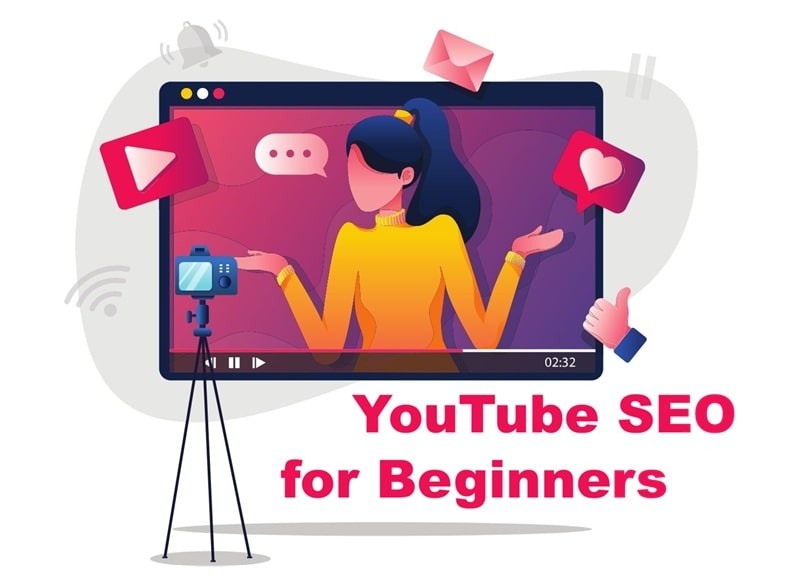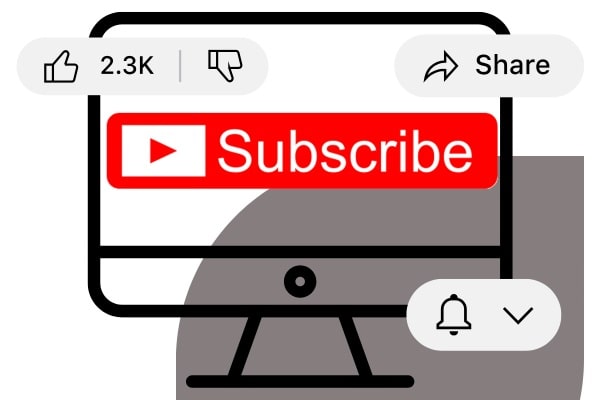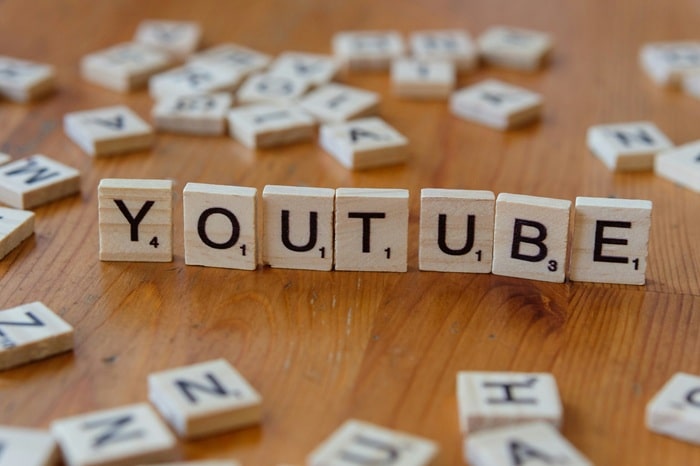YouTube is the second-largest search engine in the world, right after Google. With over 2.5 billion users logging in every month, competition for attention is fierce. That’s why YouTube SEO Optimization is no longer optional – it’s essential if you want your videos to be discovered, watched, and shared.
As a YouTuber or aspiring YouTube Channel owner, I welcome you to carefully read this whole post, re-read if needed, take your notes, and apply the following YouTube SEO optimization tips to your channel, so you can build a successful (and profitable – I know you’re thinking that 🫡) career on YouTube.

But what exactly does SEO for YouTube mean? And how do beginners optimize their videos without feeling overwhelmed? The good news is, you don’t need to be a marketing expert to start seeing results. With a clear strategy, the right tools, and consistent effort, you can improve your YouTube search optimization and get more views on your videos – no matter your niche.
(And if you’re a creative, we’ve got how to choose a creative niche covered, too. 😉)
In this guide, we’ll break down everything you need to know about YouTube SEO for beginners: what it is, how it works, which tools to use, and actionable steps to improve your rankings. Along the way, you’ll find comprehensive tables and practical tips.
By the end of this post, you’ll have a step-by-step guide to increase your visibility, reach the right audience, and grow your YouTube channel with confidence.
- SEO helps YouTube videos rank higher: Optimize titles, tags, and descriptions to appear in search and suggested videos.
- Watch time & engagement matter most: YouTube rewards videos that keep people watching and interacting (likes, comments, shares).
- Use the right tools: TubeBuddy, VidIQ, and Ahrefs can reveal keywords and ranking opportunities to grow faster.
- Blogging multiplies your reach: Embedding your YouTube videos on a blog helps you appear on Google too. Start your site with DreamHost and build your creator hub.
- Shorts and voice search are the future: Optimize short-form videos and conversational keywords to stay ahead of trends.
You may also like: 10 Best Affordable Email Service Providers for Small Business Owners
What is YouTube SEO? (YouTube SEO Meaning)
YouTube SEO Optimization refers to the process of improving your videos, playlists, and channel so they rank higher in YouTube’s search results and recommendations. Just like Google SEO, it’s all about helping the algorithm understand your content and convincing viewers to click, watch, and engage.
At its core, YouTube search engine optimization involves:
- Using the right YouTube SEO keywords in your title, description, and tags.
- Writing engaging descriptions that include both primary and LSI keywords.
- Creating eye-catching thumbnails that increase your click-through rate.
- Adding accurate captions and subtitles for accessibility and keyword indexing.
- Encouraging likes, comments, and subscriptions to boost your video’s authority.
Unlike traditional Google SEO, YouTube’s algorithm also considers viewer behavior. Metrics like watch time, average view duration, and engagement play a big role in how your content performs. That’s why YouTube SEO best practices go beyond keywords – it’s about creating videos people want to watch until the end. But we’ll talk about it more in-depth later.
Read next: Bloggers and Influencers: Differences, Profitability & The Best Choice In 2025
SEO for YouTube Shorts
With the explosive rise of short-form video, optimizing your YouTube Shorts is just as important as optimizing your longer content. Shorts often get pushed to audiences through the Shorts shelf and the YouTube homepage, but search optimization still plays a role in making sure the right viewers find them.
While the principles of YouTube SEO optimization apply across all video types, Shorts have their own quirks because they’re under 60 seconds and designed for quick, vertical viewing.
Here’s a quick optimization checklist for Shorts:
| Element | Optimization Tip |
|---|---|
| Title | Include SEO YouTube keywords, keep it under 60 characters |
| Description | 1–2 keyword-rich sentences plus links to channel/website |
| Hashtags | Use #Shorts + 2–3 niche-specific hashtags |
| Captions | Add accurate captions for accessibility and SEO |
| Engagement | Ask viewers to comment, boosting SEO signals |
Editor’s note: If you have any trouble viewing the table on your mobile device, please try rotating your screen!
Now let’s go a little deeper – so you can make the most of your short-form content!
Title and description
First, your title and description matter just as much as with long-form videos. Use YouTube SEO keywords that reflect exactly what the short is about. For example, if your Short shows a quick pasta recipe, a keyword-rich title like “Easy 60-Second Pasta Recipe | YouTube Shorts” ensures both search and Shorts viewers find it.
Hashtags
Hashtags are also crucial for Shorts. Adding #Shorts and niche-specific tags (#FitnessTips, #DIYDecor) increases discoverability within YouTube’s dedicated Shorts shelf. Pairing these with a strong thumbnail still helps because Shorts can appear in regular search results, too.
Engagement
Engagement plays a massive role in Shorts’ ranking. Since videos are brief, the completion rate is often higher, and YouTube favors Shorts that viewers rewatch or engage with (likes, shares, quick comments). That means hooks are vital: capture attention in the first 2–3 seconds or risk being swiped away.
Consistency
Finally, consistency matters. Posting Shorts regularly helps the algorithm recognize your channel as active and gives you more chances to show up in the Shorts feed. Combine that with optimized metadata, and you can generate a steady stream of organic traffic.
In short, YouTube Shorts SEO relies on the same foundation as long-form optimization, but with extra focus on speed, hashtags, and rewatch value. Nail those elements, and your Shorts can become powerful discovery tools for your channel.
👉 Pro Tip: If you’re monetizing your Shorts or selling products, connect your channel with WooCommerce to create an online store and link products directly in your video descriptions. You can connect your WooCommerce store with a FREE print-on-demand clothing provider that will print and handle shipping and returns for you! 🎉
Is Google SEO the Same as YouTube SEO?
At first glance, Google SEO and YouTube SEO Optimization might seem similar – after all, both rely on keywords and ranking algorithms. But there are important differences.
Google’s search engine primarily ranks websites based on relevance, backlinks, page speed, and authority. On the other hand, YouTube search optimization considers not only keywords but also how people interact with your video. Metrics like watch time, retention rate, likes, and comments weigh heavily in rankings.
Key differences at a glance:
- Google SEO → Focus on backlinks, domain authority, and written content.
- YouTube SEO → Focus on engagement, click-through rate, and watch time.
- Shared factors → Keyword optimization, metadata, mobile-friendliness.
👉 Pro Tip: Use KWFinder to research long-tail keywords for your niche. As YouTube videos also appear on Google searches, that’s a great way to boost your channel with free views from Google, too!
In short, while both platforms rely on strong SEO strategies, YouTube search engine optimization is more dynamic, blending keyword use with audience behavior. Mastering both gives you an edge, especially if you’re running a channel alongside a website or blog.
Related: Blogging or YouTube, Which One is More Profitable?
Does SEO Really Work for YouTube?
The short answer: yes, SEO works for YouTube, but it’s not magic, and it’s not instant. Just like Google, YouTube is a search engine that organizes and ranks billions of pieces of content. When someone searches for a video, the algorithm has to decide which ones appear first. That decision is based on dozens of factors – and SEO is how you influence them in your favor.
SEO works because YouTube’s algorithm relies heavily on:
- Relevance: Does the video match what users are searching for?
- Engagement: Are viewers liking, commenting, and sharing?
- Watch time: Are people staying until the end?
Think of YouTube SEO optimization as a way to make your video “readable” to both viewers and algorithms. Metadata, such as titles, descriptions, tags, and captions, helps YouTube understand the topic of your video. At the same time, watch time, retention, and engagement show whether people actually find it valuable. When both metadata and user signals line up, your video gains credibility and climbs higher in search results.

Many beginners expect SEO to deliver overnight success, but in reality, it’s a long-term strategy. You might not see results for weeks or even months, especially in competitive niches. However, the payoff is worth it: once a video starts ranking for the right YouTube SEO keywords, it can generate consistent views for years without additional promotion.
Real-world examples prove this point. Evergreen tutorials, product reviews, and “how-to” videos often rack up millions of views over time, not because they went viral, but because they were optimized for search and continue to rank. So, while SEO isn’t a quick fix, it’s one of the most sustainable ways to build an audience on YouTube.
Bottom line: YouTube SEO Optimization won’t guarantee overnight viral success, but it builds long-term visibility and authority.
Here’s an example of how YouTube SEO optimization really works for beginners:

Imagine a small fitness creator uploads a “10-Minute Morning Yoga for Beginners” video. At first, it only gets a few hundred views. But because the title includes long-tail keywords (“morning yoga for beginners”), the description explains the benefits clearly, and captions were added, YouTube quickly understands the video’s relevance.
Over time, as viewers watch to the end and leave comments like “This routine really helps me start the day,” the algorithm picks up on those strong user signals.
After a few months, the video ranks on page one for “morning yoga” and continues to bring in thousands of new viewers every week – without the creator spending a dime on ads.
This is how SEO works in practice: a slow but steady climb that can turn a single well-optimized video into a long-term traffic driver.
👉 Pro Tip: Embedding videos into written content helps your SEO across both YouTube and Google, driving more traffic back to your channel. You can start a blog for $2.99/mo with DreamHost to help boost your videos and even monetize both your YouTube channel and your blog separately.
How to Optimize SEO on YouTube?
Want some good news?
YouTube SEO Optimization is highly actionable. With the right steps, you can significantly boost your video’s visibility.
For example, videos that use optimized titles and keyword-rich descriptions can see up to 2x more views compared to those without. Add compelling thumbnails and strong audience retention, and you’ll improve your overall SEO score on YouTube.
Here’s a practical optimization checklist:
| Element | Optimization Tip | Recommended Tool |
|---|---|---|
| Title | Include your main YouTube SEO keywords within 60 characters | YouTube Title SEO Checker, TubeBuddy SEO |
| Description | Write 200+ words, include LSI keywords, add links | VidIQ, KWFinder |
| Tags | Use 5–15 relevant SEO YouTube keywords | TubeBuddy, Ahrefs |
| Thumbnails | High-quality visuals with text overlays | Canva, Photoshop |
| Subtitles | Upload accurate captions to improve discoverability | Rev.com, YouTube Auto-Captions |
| Engagement | Ask viewers to like, comment, and subscribe | N/A |
Editor’s note: If you have any trouble viewing the table on your mobile device, please try rotating your screen!
Optimizing SEO on YouTube is about making your videos easy for the platform to understand, rank, and recommend. Unlike traditional SEO on Google, YouTube SEO requires balancing metadata optimization with viewer engagement signals. Here’s a step-by-step breakdown of how to do it effectively:
- Keyword Research → Start by identifying what your audience is searching for. Use tools like TubeBuddy, VidIQ, or even YouTube’s autocomplete to find long-tail YouTube SEO keywords with lower competition. Aim for terms that match user intent, like “how to edit videos on iPhone free” instead of the broad “video editing.”
- Title Optimization → Your title should be clear, keyword-rich, and clickable. For example, instead of “Great Fitness Tips,” write “10-Minute Morning Workout for Beginners (No Equipment).” This blends SEO with audience appeal.
- Description & Tags → Use the description to summarize your video with keywords naturally woven in. Add timestamps for clarity and links to relevant playlists. Tags matter less than they used to, but including variations of your main keyword still helps.
- Thumbnails → While thumbnails don’t contain keywords, they directly impact CTR (click-through rate). A well-designed, high-contrast thumbnail with text overlay can make the difference between ranking and being ignored.
- Captions & Subtitles → Adding captions improves accessibility and helps YouTube understand your content better, boosting SEO.
- Engagement Signals → Encourage viewers to like, comment, and share. These interactions tell YouTube your content is valuable.
In short, YouTube SEO optimization means aligning on-page elements (titles, tags, captions) with off-page behavior (watch time, engagement, retention). The more your video matches what people search for and keeps them watching, the more likely YouTube is to reward you with higher rankings.
Read next: Best Platforms to Monetize Skills and Make Money Online
Long-Tail vs. Short-Tail Keywords in YouTube SEO
When starting with YouTube SEO Optimization, one of the most important decisions is which keywords to target. Keywords generally fall into two categories: short-tail and long-tail.
Short-tail keywords are broad and very competitive. For example, “fitness” or “cooking.” Millions of videos may already target them, making it difficult for a new channel to rank. While these keywords can bring high search volume, they’re rarely realistic for beginners.
Long-tail keywords, on the other hand, are more specific. Think “10-minute beginner fitness workout at home” or “easy pasta recipes for college students.” These terms may get fewer searches individually, but they attract a more targeted audience – people actively looking for the exact content you’re creating.
For beginners, long-tail keywords are the smarter choice because they:
- Attract engaged viewers → Users searching detailed queries are more likely to watch your full video.
- Boost SEO signals → Higher retention and engagement help your video rank for broader terms later.
- Face less competition → You’re not trying to outrank huge established channels.
Video Optimization Beyond Metadata

Optimizing titles, descriptions, and tags is only part of YouTube SEO optimization. YouTube’s algorithm also looks at how viewers actually interact with your content. Factors like watch time, engagement, and playlists send strong signals about quality and relevance. Here’s how each impacts your rankings:
Does Watch Time Affect YouTube SEO?
Yes – watch time is one of the most important ranking factors in YouTube search optimization. YouTube wants to keep users on its platform as long as possible, so videos that hold attention are rewarded with more visibility.
When viewers watch most or all of your video, YouTube interprets this as a signal that your content matches the searcher’s intent. On the other hand, if people click and quickly leave (a high bounce rate), it can hurt your SEO score on YouTube.
To improve watch time:
- Edit tightly to remove filler and keep pacing engaging.
- Hook viewers in the first 15 seconds with a clear value statement.
- Use storytelling, visuals, or step-by-step structures to maintain interest.
How Engagement (Likes, Comments, Shares) Boosts SEO
Another key factor in YouTube video SEO is engagement. Metrics like likes, comments, shares, and even subscribers gained after watching a video all tell YouTube that people find your content valuable.
For example, a video with average watch time but high comment activity may still rank well because it sparks meaningful interaction. Similarly, shares amplify your reach beyond YouTube, signaling that viewers find your content worth recommending.
Boosting engagement doesn’t happen by accident. Encourage interaction with calls to action like:
- “Comment your experience below.”
- “Like this video if you found it helpful.”
- “Share this with a friend who needs these tips.”
Engagement also builds community, which keeps viewers coming back – another long-term YouTube SEO best practice.
YouTube Playlists and SEO
Playlists aren’t just for organizing videos. They’re a powerful tool for YouTube channel optimization. When you group videos into playlists, you encourage viewers to watch multiple videos in a row, boosting session watch time, which the algorithm loves.
Playlists also rank in search results themselves, meaning a single playlist can bring in additional traffic beyond individual videos. For example, instead of just ranking for “YouTube SEO tips,” a playlist called “YouTube SEO Optimization for Beginners” can show up, too!
Optimizing playlists is simple:
- Use keyword-rich titles and descriptions.
- Arrange videos in a logical order (step-by-step or topic-based).
- Add compelling custom thumbnails for consistency.
Playlists also help with suggested videos. If a viewer finishes one of your videos, YouTube will naturally suggest the next in the playlist, reducing drop-offs and increasing overall engagement.
Voice Search and YouTube SEO
With the rise of smart devices, virtual assistants, and mobile-first browsing, voice search is changing the way people find videos. Instead of typing short phrases like “best camera settings,” users often speak in full, natural sentences such as “What are the best camera settings for recording YouTube videos?”
This shift has major implications for YouTube SEO optimization.
When optimizing for voice, the key is to prioritize long-tail, conversational keywords. These phrases are closer to how people actually talk. For example, instead of only targeting “workout tips,” you might also include “What are the best workout tips for beginners at home?” in your description or video script. This improves your chances of being surfaced when someone uses a voice assistant or mobile device to search.
Another important factor is video titles and descriptions. While you don’t want to make them overly long, including natural, question-based phrasing helps align your content with voice queries. A title like “How to Start a YouTube Channel on Your Phone (Step-by-Step Guide)” works better for voice than just “YouTube Channel Setup.”
Quick Tips to Optimize for Voice Search
- Use long-tail, conversational keywords in titles and descriptions.
- Include question-based phrases like “how to…” or “what is…” in your content.
- Speak naturally in your video script so your transcript aligns with real speech.
- Always add captions and transcripts for extra keyword recognition.
- Create content that directly answers questions quickly to match voice intent.
In short, optimizing for voice search means thinking less like a keyword list and more like a conversation. By focusing on natural, long-form phrases, you’ll be ahead of the curve as voice-driven searches continue to grow.
Do Subtitles and Captions Help with YouTube SEO?
Yes, they do – and here’s why: YouTube’s algorithm can “read” your subtitles and captions, which helps it understand your video content better. This increases your chances of ranking for relevant SEO keywords for YouTube.
Benefits of adding subtitles and captions:
- Improved SEO: Keywords in captions are indexed by YouTube.
- Accessibility: Viewers with hearing impairments or those watching on mute benefit.
- Global reach: Subtitles in multiple languages expand your audience.
So yes, accurate subtitles and captions are a simple but powerful YouTube SEO Optimization tactic you should always use.
🌍 Accessibility & Global Reach: How to Use Translations and Captions for SEO
Captions and translations are not only about accessibility – they’re also powerful tools for YouTube SEO optimization. Adding captions ensures that your content is accessible to viewers with hearing impairments, while also giving YouTube’s algorithm more text to analyze. The platform can “read” captions and better understand your video’s content, which helps with indexing.
Translations expand this benefit further. By offering subtitles in multiple languages, you open your videos to international audiences.
A tutorial in English with Spanish or Portuguese captions, for example, can reach millions more viewers.
Beyond accessibility, this increases watch time and engagement, both critical ranking factors. For creators aiming to grow globally, investing time in captions and translations is a simple but effective way to maximize reach and boost SEO.
YouTube Tracking & Analytics

Creating videos with strong titles, tags, and thumbnails is only part of the equation. To know if your YouTube SEO optimization efforts are actually working, you need to measure results. Tracking performance through YouTube Studio and specialized SEO tools helps you understand what the algorithm sees and how your audience behaves.
By regularly reviewing analytics, you can refine your approach and make data-driven improvements that increase visibility over time.
How to Measure SEO Success on YouTube
Success in YouTube search engine optimization is not measured by a single number. Instead, it’s the result of multiple metrics that reflect how well your video attracts viewers and keeps them engaged. YouTube Studio provides an extensive set of analytics, but here are the most important ones for SEO:
- Impressions → This shows how many times your video’s thumbnail was displayed on YouTube. A high number of impressions means YouTube is giving your video visibility.
- Click-Through Rate (CTR) → Out of all those impressions, CTR shows the percentage of people who actually clicked. This metric is heavily influenced by your title and thumbnail quality.
- Audience Retention → This indicates how long viewers watch your video. Higher retention tells YouTube your content is relevant and worth recommending.
- Average View Duration → Similar to retention, but focused on the average time people stay before leaving. Long average durations improve your ranking chances.
- Engagement Metrics → Likes, comments, and shares don’t just build community – they also signal that your video sparks interaction.
- Traffic Sources → This tells you where views are coming from: YouTube search, suggested videos, or external sites. Search-driven traffic shows your SEO is working.
Measuring these over time gives you a full picture of your SEO performance. For instance, if your impressions are high but CTR is low, you may need stronger thumbnails. If CTR is good but retention is weak, your video content or pacing needs improvement.
Using YouTube SEO Checker Tools
While YouTube Studio provides a lot of valuable data, it doesn’t always show you what’s missing in your optimization. That’s where YouTube SEO checker tools come in. These platforms analyze your videos and channel, then provide an SEO score or checklist that highlights areas for improvement.
Tools like TubeBuddy, VidIQ, and Morningfame can scan your metadata to see if you’ve included your main YouTube SEO keywords in the title, description, tags, and even your thumbnail text. They can also tell you if your description length is too short, if you’re missing closed captions, or if your tags aren’t aligned with your target keywords.
Competitor benchmarking
One of the most useful aspects of these tools is competitor benchmarking. You can compare your video against top-performing ones in your niche. This helps you understand why another creator might rank higher for the same keyword. For example, they may have a higher retention rate, longer watch time, or stronger keyword placement in their metadata.
Optimization gaps
Another benefit of SEO checker tools is their ability to reveal optimization gaps. Perhaps you forgot to add end screens, or your tags don’t match your title. Small oversights like these can add up and hurt your video’s visibility. By running regular audits, you make sure every video meets the best practices of YouTube video SEO.
Use YouTube SEO checker tools as a complement
Ultimately, these tools don’t replace analytics – they complement them. Think of YouTube Studio as showing you how your video performs, while SEO checkers show you why it performs that way and what to fix. Combining both gives you a clear roadmap to refine your strategy and steadily grow your channel.
Can You Pay Someone to Do SEO for Your YouTube Channel?
Yes, you can absolutely hire a YouTube SEO expert or agency to optimize your channel. But whether it’s worth it depends on your goals and budget.
Pros of hiring SEO services for YouTube:
- Save time by letting professionals handle keyword research and optimization.
- Get access to advanced tools and strategies.
- Potentially faster growth if combined with strong content.
Cons:
- Services can be expensive, ranging from $300 to $2,000+ per month.
- No guarantees – SEO takes time regardless of who does it.
- Some “experts” may overpromise results.
👉 Pro Tip: If you’re not ready for ongoing costs, try learning the basics first (with tools like TubeBuddy and KWFinder) and only outsource once you’ve validated your content strategy.
In many cases, creators start with DIY optimization, then scale up by hiring a YouTube SEO specialist once their channel is monetized.
Can I Do SEO on My Own?

Yes, you can – and in fact, many successful creators handle YouTube SEO Optimization themselves, at least in the beginning. While hiring a YouTube SEO specialist can save time, learning to optimize your own content gives you full control over your strategy and helps you understand what actually works for your audience.
Doing SEO on your own starts with keyword research. Tools like KWFinder, TubeBuddy, or VidIQ make it simple to discover what people are searching for in your niche. Look for long-tail keywords with moderate competition – they’re easier to rank for and often bring in highly targeted viewers.
Once you’ve found your keywords, focus on on-page optimization:
- Craft a title that’s engaging but includes your primary keyword.
- Write a description of at least 200 words, weaving in YouTube SEO keywords naturally.
- Add 5–15 relevant tags to give YouTube context.
- Upload a high-quality thumbnail with a strong visual hook.
Don’t forget subtitles and captions – they not only make your videos accessible but also improve SEO by giving YouTube more text to index.
The final step is monitoring your performance in YouTube Analytics. Look at your SEO score for YouTube metrics like impressions, click-through rate, and watch time to see what’s working. Over time, you’ll notice patterns and refine your process.
👉 Pro Tip: Starting a blog alongside your channel can multiply your efforts. Embed your videos into blog posts targeting the same keywords – this creates backlinks, boosts your authority, and drives viewers from Google straight to your channel.
How Long Does YouTube SEO Take?
One of the most common questions beginners ask is: “When will I see results from YouTube SEO Optimization?” The honest answer is: it depends. Unlike paid ads, SEO is a long-term investment, and results vary based on factors like competition, content quality, and consistency.
In competitive niches – like gaming, beauty, or finance – it can take 3–6 months before you see noticeable growth from YouTube search engine optimization. But in smaller niches with less competition, you might notice traction within a few weeks. The key is to stay consistent and patient.
Several factors affect how quickly your videos rank:
- Competition: Broad, high-traffic keywords take longer to rank for. Start with long-tail YouTube SEO keywords.
- Engagement metrics: If people click, watch, and comment, YouTube rewards your video faster.
- Consistency: Uploading regularly signals to the algorithm that your channel is active.
- Optimization quality: Using SEO checker tools ensures your titles, descriptions, and tags are properly optimized.
It’s also important to remember that YouTube favors evergreen content. A well-optimized tutorial or how-to video can continue generating views for years.
So, while YouTube SEO takes time, the results are worth the wait. Think of it as planting seeds – with consistency and the right strategy, your channel will grow into a steady source of views, subscribers, and income.
How to Do SEO for Beginners?
If you’re new to YouTube SEO Optimization, the process may feel intimidating at first. But don’t worry! Even complete beginners can improve their visibility with a few consistent practices. The key is breaking down YouTube search optimization into small, actionable steps.
Start with keyword research. Tools like TubeBuddy, VidIQ, or KWFinder help you uncover what people are actually searching for. Look for SEO YouTube keywords that balance search volume with lower competition. Long-tail phrases are especially beginner-friendly since they’re easier to rank for and often attract more engaged viewers.
Once you’ve chosen your keywords, move on to video optimization:
- Write a compelling title that includes your main keyword.
- Create a description with at least 200 words, weaving in related keywords and links to your website or store.
- Use tags strategically, focusing on relevance rather than stuffing.
- Design a custom thumbnail with bold text and clear visuals to boost click-through rates.
Adding subtitles, as we’ve already seen earlier in this post, is another powerful beginner tactic. Not only do they improve accessibility, but they also give YouTube more context about your content, improving your SEO score on YouTube.
Finally, track your progress in YouTube Studio Analytics. Watch for impressions, CTR, watch time, and retention rates. These metrics show you whether your optimization is working.
👉 Pro Tip: Pair your channel with an eCommerce store powered by WooCommerce. For creators who plan to sell merchandise, courses, or products, having a connected store makes monetization seamless while your SEO gains momentum.
What is the Best SEO Tool for YouTube?
There’s no single “perfect” tool – the right one depends on your goals, experience, and budget. Below are some of the best YouTube SEO tools and strategies every creator should consider.
Here’s a quick table of some of the best tools for YouTube SEO:
| Tool | Best For | Why It Matters for YouTube SEO |
|---|---|---|
| TubeBuddy | Keyword research, metadata optimization, competitor tracking | Helps identify YouTube SEO keywords, optimize titles/descriptions, and compare performance against competitors. |
| VidIQ | Analytics, keyword tracking, real-time SEO scores | Gives insights into CTR, watch time, and trending topics, plus actionable tips to improve SEO score on YouTube. |
| Ahrefs & SEMrush | Advanced keyword research and cross-platform SEO | Great for finding long-tail keywords, analyzing Google + YouTube search overlap, and planning integrated SEO strategies. |
| Blogging & Google SEO Integration | Driving external traffic from blogs to YouTube | Publishing blog posts with embedded videos helps videos rank on Google and boosts YouTube SEO through external traffic. |
| Morningfame | Beginner-friendly analytics and growth tracking | Simplifies SEO with intuitive grading, keyword suggestions, and clear growth reports for small creators. |
| Canva | Thumbnails, branding, and channel graphics | Eye-catching thumbnails increase CTR, while consistent branding strengthens authority and improves recognition in search results. |
Editor’s note: If you have any trouble viewing the table on your mobile device, please try rotating your screen!
👉 Pro Tip: Start with a free tool like TubeBuddy or VidIQ to explore YouTube SEO keywords. As your channel grows, consider advanced tools like Ahrefs to build a stronger YouTube SEO marketing strategy.
Now, let’s check each one of these SEO tools for YouTube more in-depth:
TubeBuddy for YouTube SEO Optimization
TubeBuddy is one of the most popular tools for creators, and for good reason. It integrates directly into YouTube as a browser extension, offering a suite of features that simplify the YouTube SEO optimization process.
With TubeBuddy, you can perform YouTube SEO keyword research directly inside the platform, checking search volume, competition, and relevancy. This makes it easier to find long-tail keywords that beginners can rank for. The built-in YouTube title SEO checker also helps you craft keyword-rich titles while keeping them attractive for viewers.
Another standout feature is its thumbnail A/B testing. Since thumbnails directly impact click-through rates, TubeBuddy allows you to experiment and identify which style drives the most engagement. Add to this bulk editing of descriptions, tag suggestions, and upload checklists, and you’ve got a tool that saves time while improving your SEO score on YouTube.
👉 Best For: Beginners to intermediate creators who want an all-in-one, easy-to-use tool.
VidIQ for YouTube Search Engine Optimization
If you’re someone who thrives on data-driven insights, VidIQ might be the best fit. Known for its robust analytics and competitor analysis, VidIQ goes beyond basic keyword suggestions to provide a deep look at how your videos – and your competitors’ – perform.
VidIQ assigns an SEO score for YouTube videos, showing how well your metadata aligns with search optimization best practices. It also suggests SEO YouTube keywords to include in your titles, tags, and descriptions. The real power, however, lies in its competitor tracking. You can analyze other channels in your niche, identify which videos are ranking, and replicate their strategies with your own twist.
The platform also helps with YouTube SEO for beginners by offering daily ideas based on trending searches. This ensures you never run out of content ideas that have proven demand. For more established channels, advanced features like historical data tracking and real-time performance alerts give you a professional edge.
👉 Best For: Creators who want to dig deep into analytics and competitor research.
👉 Pro Tip: Use VidIQ alongside WooCommerce if you sell products. You can monitor which types of videos bring in the most traffic and then optimize those videos to promote your store more effectively.
Ahrefs and SEMrush for Advanced Keyword Research
For creators who want to go beyond YouTube’s ecosystem, Ahrefs and SEMrush are two powerhouse tools that bring broader SEO intelligence into the mix. While primarily built for Google SEO, they’re invaluable for discovering keywords that overlap between Google and YouTube searches.
Both tools allow you to conduct YouTube SEO keyword research at scale, identifying search terms with strong traffic potential. They also reveal whether certain keywords rank video results in Google SERPs – a golden opportunity for visibility. For example, if “how to set up a YouTube channel” shows both blog posts and videos on page one of Google, targeting that keyword means double exposure: in YouTube search and Google search.
Ahrefs and SEMrush also provide competitor insights, backlink tracking, and content gap analysis. These features let you identify which topics your competitors cover that you haven’t yet – giving you an edge in both YouTube SEO marketing and traditional blogging.
👉 Best For: Businesses, marketers, and advanced creators who combine video with broader digital marketing strategies.
👉 Pro Tip: If you’re serious about scaling, use Ahrefs to build blog posts around your videos. With a reliable web host like DreamHost, you can create a blog that ranks on Google while embedding your YouTube videos for maximum visibility.
Blogging and Google SEO Integration
While tools like TubeBuddy and VidIQ help inside YouTube, blogging is often the overlooked powerhouse for YouTube channel optimization.
Why?
Let me explain.
Google often shows YouTube videos alongside written articles in its search results. By creating a blog to accompany your channel, you give yourself two chances to rank: one with your blog post, and one with your video.
Here’s how it works:
- Do YouTube SEO keyword research to find a topic (e.g., “YouTube SEO for beginners”).
- Write a blog post of at least 1,500 words targeting that keyword.
- Embed your video in the post, optimize the alt text, and add transcripts.
- Promote both the blog and the video across your social channels.
This creates a powerful SEO synergy. Viewers who discover your blog may watch your video, boosting YouTube watch time. Meanwhile, embedding the video can increase dwell time on your blog, signaling quality to Google.
The best? Blogging is really inexpensive. Hosting a blog with DreamHost usually costs $2.99/mo for simple blogs (not as fast and competitive, but reliable enough for beginners) and $16.95/mo for faster and safer business blogs or websites.
For those prices, you’ll get:
- secure WordPress hosting
- free SSL certificate
- free domain name (on yearly plans)
- free domain privacy (on yearly plans)
- unlimited emails @ your domain (essential for business partnerships and to get approved by affiliate networks)
So sign up for DreamHost today – and if you’re not happy, DreamHost has a 30-day money-back guarantee!
👉 Best For: Creators serious about long-term growth and building a brand beyond YouTube.
Morningfame for YouTube SEO Insights
While TubeBuddy and VidIQ dominate the market, Morningfame has carved out a niche by focusing on simplicity and clear growth insights.
Unlike other platforms that can overwhelm beginners with too much data, Morningfame distills everything into easy-to-understand metrics, making it a great choice for creators who are just starting their YouTube SEO optimization journey.
The standout feature of Morningfame is its invitation-only system. Once inside, you gain access to detailed reports that measure how your videos perform against competitors.
It offers recommendations for SEO keywords for YouTube, video engagement, and even how your channel stacks up over time. Instead of just showing raw numbers, it explains what those numbers mean for your growth strategy.
Morningfame also guides creators through the YouTube SEO keyword research process. Its keyword grading system shows you which terms are realistic to rank for based on your channel’s size. This is especially helpful for small creators who don’t yet have the authority to compete for high-volume keywords.
👉 Best For: Beginners and smaller channels that want actionable insights without information overload.
Canva for Thumbnails and Branding
When it comes to YouTube search engine optimization, keywords aren’t everything – click-through rate (CTR) is just as important. And nothing influences CTR more than your thumbnail. That’s where Canva comes in.
Canva is a free (with premium options) design tool that makes creating professional-looking thumbnails quick and easy. With drag-and-drop templates, you can design thumbnails that highlight your main keyword visually, while ensuring your videos stand out in a crowded feed. Since thumbnails directly impact whether viewers click your video, Canva indirectly plays a huge role in YouTube video SEO.
Beyond thumbnails, Canva helps you design cohesive branding across your channel. You can create channel banners, end screens, and social media posts to promote your videos – all crucial for YouTube channel optimization.
Consistency builds trust, and trust leads to higher watch time and subscriber growth, both of which feed back into better SEO performance.
👉 Best For: Creators at any level who want polished, scroll-stopping thumbnails without needing design skills.
👉 Pro Tip: Use Canva alongside keyword tools like TubeBuddy or VidIQ. Once you know your target SEO YouTube keywords, highlight them visually in your thumbnail (bold text overlays, branded colors, etc.). This reinforces your message and attracts clicks from both YouTube search and suggested videos.
YouTube SEO for Non-English Channels
While much advice about YouTube SEO is tailored for English-speaking creators, there’s a huge opportunity in non-English markets. In fact, YouTube’s global audience often has less competition in local languages, making it easier to rank. For instance, targeting long-tail SEO keywords for YouTube in Hindi, Arabic, or Spanish may yield faster results than competing in highly saturated English niches.
Non-English creators should still follow the same best practices – keyword-rich titles, optimized descriptions, and engaging thumbnails – but with a focus on local search intent. Tools like TubeBuddy and VidIQ support multiple languages, making keyword research easier. Additionally, adding dual-language titles or descriptions can capture both local and international searches.
By embracing non-English SEO strategies, creators can carve out space in rapidly growing markets, attracting loyal audiences who are underserved by global content.
YouTube SEO for Business Channels
For businesses, YouTube SEO optimization goes beyond views and subscribers – it’s about attracting qualified leads. By targeting keywords that align with customer intent, companies can position their videos as solutions to real problems.
For example, a software company can rank tutorials for “how to speed up WordPress,” drawing in potential clients.
Optimized titles, detailed descriptions, and strategic calls-to-action (CTAs) in video and description boxes guide viewers from discovery to conversion. When combined with consistent branding and playlists that showcase expertise, YouTube SEO becomes a cost-effective way to generate awareness, trust, and sales.
SEO for YouTube Ads vs. Organic Content
Paid ads and organic SEO serve different purposes but complement each other. YouTube ads guarantee visibility for a chosen audience, but once the budget stops, so does traffic.
Organic YouTube SEO, on the other hand, builds long-term visibility by ranking videos in search and suggested feeds.
Businesses often use ads to kickstart momentum on new content while relying on SEO for ongoing discoverability. Together, they form a balanced strategy: ads deliver fast exposure, while SEO ensures sustainable growth and brand authority.
Building a Funnel with YouTube SEO + Blog + WooCommerce
Ranking videos on YouTube is one road to online success. BUT – to maximize ROI and diversify income streams, YouTubers should definitely integrate YouTube SEO with blogging and WooCommerce.
For example, a video optimized for “best skincare routines” can link to a supporting blog post, which then guides visitors to a WooCommerce store selling the featured products.
Google also indexes blog content, meaning businesses get double visibility: once on YouTube, once on search engines.
Beyond driving direct sales, blogging opens additional opportunities for affiliate marketing for beginners and ad monetization. By embedding affiliate links or displaying ads in your blog posts, you can earn revenue even if visitors don’t immediately purchase from your store. This multi-channel approach not only increases conversions but also diversifies income streams, making the funnel more robust and sustainable.
By connecting YouTube SEO, content marketing, and eCommerce, companies can create a powerful system that turns viewers into loyal customers while capturing revenue from multiple sources.
You can start a blog today with DreamHost for only $2.99/mo or start a WooCommerce online store (you can add a blog to your online shop at no extra cost with WooCommerce hosting 😉) for only $16.95/mo.
Related: Easy Beginner-Friendly e-Commerce Platforms for Side Hustle in 2025
Future of YouTube SEO: Trends to Watch
YouTube SEO is constantly evolving, and staying ahead means understanding the trends that will shape the platform in the coming years.
AI-driven recommendations
One major trend is AI-driven recommendations. YouTube’s algorithm increasingly uses artificial intelligence to analyze viewer behavior and suggest content tailored to individual preferences. This means creators need to focus not just on keywords but on engagement signals like watch time, likes, and comments to ensure their videos are surfaced to the right audience.
Hyper-personalization
Another trend is hyper-personalization. Unlike the old model, where videos competed mainly on broad topics, YouTube now prioritizes content that aligns with each viewer’s interests and viewing history. Optimizing for a wider audience still matters, but creators should think in terms of niches and user intent to rank effectively.
Provide value over clickbait
Finally, the platform’s algorithms are constantly changing. YouTube increasingly rewards videos that maintain strong retention, encourage interaction, and provide value over clickbait. AI is also improving transcription, captions, and automated SEO suggestions, making metadata more important than ever.
For creators and businesses, the takeaway is clear: focus on quality, engagement, and audience understanding, not just raw keywords. Combining traditional YouTube SEO optimization with insights from AI and analytics will keep your content competitive. Staying agile and adapting to these trends ensures your videos continue to reach new viewers and maintain long-term visibility.
YouTube SEO Optimization for Beginners: Conclusion
YouTube SEO Optimization isn’t just for big creators – it’s for anyone who wants their videos to reach more people. By learning how to optimize your titles, descriptions, thumbnails, and captions, you’re giving YouTube the signals it needs to promote your content. Combine that with strong engagement and consistent uploads, and you’ll be well on your way to long-term growth.
We’ve covered everything from YouTube SEO meaning to tools, best practices, and even whether it’s worth hiring a YouTube SEO expert. The truth is, most creators can handle the basics themselves. With tools like TubeBuddy, VidIQ, and KWFinder, it’s easier than ever to research keywords, optimize metadata, and track your SEO score on YouTube.
But remember: SEO isn’t a one-time task – it’s an ongoing process. The more you experiment, learn from analytics, and refine your strategy, the better your results will be. Think of each video as a new opportunity to grow, connect with your audience, and increase your reach.
👉 Next Steps:
- Pick your next video idea and run it through KWFinder or TubeBuddy.
- Optimize the title, description, and thumbnail using today’s checklist.
- Build a companion website/blog with DreamHost and embed your videos for cross-platform SEO.
- If you’re selling products or merch, set up WooCommerce for seamless integration.
By applying these YouTube SEO best practices, you’ll build not just views, but also a sustainable channel that grows with you.
YouTube SEO Optimization for Beginners: FAQ
How to get 100% SEO score on YouTube?
To maximize your SEO score, optimize your title, description, tags, and thumbnail for relevant keywords. Add captions, create engaging content to boost watch time, and encourage likes, comments, and shares. Consistent uploads and high audience retention signal to YouTube that your video is valuable, helping it rank higher in search results and suggested feeds.
Can you boost YouTube videos so they are found in SEO?
Yes, boosting videos through SEO means optimizing titles, descriptions, tags, and thumbnails, while focusing on audience engagement and retention. Promoting your content via social media, blogs, or email lists can also drive traffic. YouTube rewards videos that attract real viewers who watch and interact, which helps improve visibility in search and recommendations.
How do I add SEO to my video?
Add SEO by researching relevant keywords, then including them in your title, description, and tags. Create engaging thumbnails, use accurate captions, and organize content into playlists. Encourage viewers to interact through likes, comments, and shares, which signals relevance to YouTube’s algorithm and helps your video rank higher in search results.
Can I pay YouTube to promote my content?
Yes, YouTube Ads lets you pay to promote videos, appearing in search results, suggested feeds, or on other channels. While ads boost visibility quickly, they don’t replace SEO. Optimized videos gain organic reach over time, whereas paid promotion is temporary. Combining both strategies often delivers the best results.
Is SEO worth it anymore?
Absolutely. While algorithms evolve, SEO is still critical for discoverability and long-term growth. Optimized videos reach more viewers organically, build credibility, and maintain visibility without ongoing ad spend. SEO ensures your content is aligned with what users are searching for, giving it a lasting presence on YouTube and even Google search results.
Is SEO easy to learn?
Yes, YouTube SEO is beginner-friendly, but it requires consistent effort. Start by learning keyword research, optimizing titles and descriptions, and creating engaging content. Tools like TubeBuddy or VidIQ simplify the process. With practice, understanding analytics, audience behavior, and best practices becomes intuitive, making SEO a skill that can grow with your channel.






